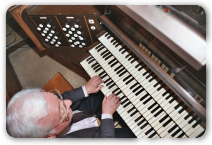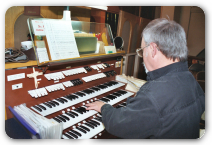1-866-759-7807 (toll-free)
Servicing the Entire Northeast!
Dedication of Lemieux & Associates Pierce Memorial Pipe Organ at Bethesda Episcopal Church, Saratoga Springs NY
read more
Lemieux & Associates begins work on the revitalization of the 1854 E. & G.G. Hook Pipe Organ at Winthrop St. Baptist Church, Taunton, MA.
read more
Lemieux & Associates prepare the Organ at St. Anne's Church and Shrine in Fall River, MA, for the churches 100th Anniversary Concert.
read more

Daniel
Lemieux,
has been actively involved in the world of music and pipe organs since childhood. learn
more

Get A Free
Quote
Get a custom-prepared evaluation and proposal for restoration or renovation free of charge. learn
more

Download Free
Music
Listen to beautiful pipe organ music for free! listen
Digital technology is used in pipe organs to replace worn out electrical or pneumatic switching and combination systems.  Digital systems are very reliable and allow for many integrated features such as multi-memory levels, transposer, record and playback ability, programmable crescendo pedal, MIDI compatibility, etc. Many of our projects involve replacing old electrical parts (i.e. console hardware, contacts, switching relays, etc.) with modern solid state and/or digital systems. The organ is a very complicated and multi-faceted instrument under the control of only one player. Digital technology makes the instrument far more versatile, reliable, and easier to work with. Features such as multiple levels of memory allow an organist to concentrate a little more on making music rather than controlling the auxiliary functions of the instrument. The record and playback feature, actually improves musicianship, because an organist can record a piece, then go out into the sanctuary and listen to how they play. The organ plays back exactly what was played, including stop changes and swell box shutter movements. If desired, it can even be used to pre-record anthems, so the organist can concentrate on conducting during a live performance.
Digital systems are very reliable and allow for many integrated features such as multi-memory levels, transposer, record and playback ability, programmable crescendo pedal, MIDI compatibility, etc. Many of our projects involve replacing old electrical parts (i.e. console hardware, contacts, switching relays, etc.) with modern solid state and/or digital systems. The organ is a very complicated and multi-faceted instrument under the control of only one player. Digital technology makes the instrument far more versatile, reliable, and easier to work with. Features such as multiple levels of memory allow an organist to concentrate a little more on making music rather than controlling the auxiliary functions of the instrument. The record and playback feature, actually improves musicianship, because an organist can record a piece, then go out into the sanctuary and listen to how they play. The organ plays back exactly what was played, including stop changes and swell box shutter movements. If desired, it can even be used to pre-record anthems, so the organist can concentrate on conducting during a live performance.
As digital technology matures, it can also be used to recreate additional sampled (recorded) pipe sounds, which are especially useful in the bass where the pitches are low and tend to be less subtle. We incorporate only the very best digitally sampled technology available, custom voiced by our firm to achieve the optimal sound for your sanctuary. These digital ‘stops’ would appear on the console as a normal draw knob or stop tab, and are used as an integrated part of the instrument, just like any other stop. Digital ranks are best used as a compliment to the pipes, rather than a substitute. The judicious use of custom tailored digital tone generating technology, carefully voiced to work naturally and cohesively with real pipework, is an extension of the pipe organ tradition, and an expression of our age. In certain circumstances, such as when dealing with space constrains, it provides a very practical solution that should be considered.
 Unlike electronic organs which have a lifeless ‘flat’ or unnatural sound, digital additions use real pipes which have been sampled (recorded). You are actually hearing the attack, release, and tone of a recorded pipe. Sensors which monitor and follow the pitch of the real pipes continually provide feedback to the computer which controls the tuning of the digital stops so they are coherent with the pipes. In addition, imperfections in tuning or speech are retained, giving the sound more vitality and life. The key to making it sound good is to carefully select and voice the digital sounds to the room and to the real pipework. With digital, less is more. The sound of an instrument should be organic and consistent with the room. It’s this subtle point that makes most mass-produced electronic/digital instruments so ungratifying and incongruent with their surroundings. Digital supplements are particularly effective in the pedal division where the cost of pipework is expensive due to its size, and sometimes difficult to fit in the space available.
Unlike electronic organs which have a lifeless ‘flat’ or unnatural sound, digital additions use real pipes which have been sampled (recorded). You are actually hearing the attack, release, and tone of a recorded pipe. Sensors which monitor and follow the pitch of the real pipes continually provide feedback to the computer which controls the tuning of the digital stops so they are coherent with the pipes. In addition, imperfections in tuning or speech are retained, giving the sound more vitality and life. The key to making it sound good is to carefully select and voice the digital sounds to the room and to the real pipework. With digital, less is more. The sound of an instrument should be organic and consistent with the room. It’s this subtle point that makes most mass-produced electronic/digital instruments so ungratifying and incongruent with their surroundings. Digital supplements are particularly effective in the pedal division where the cost of pipework is expensive due to its size, and sometimes difficult to fit in the space available.
"What a difference. For once, I can pull out stops and not worry about what I’m going to hear... Thanks so much for making the organ a great instrument to play again!"
-David Langevin, Organist
